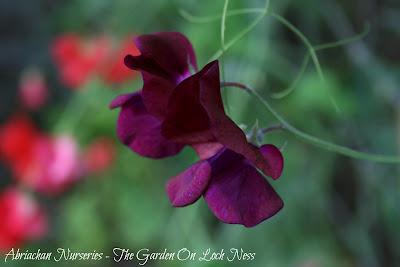The stems are getting shorter and there is more than a little late infestation of green fly, but they have been magnificent and as they say “owe us nothing".
I have always loved sweet peas. They have been an annual highlight and the first few blooms are always eagerly awaited and their scent inhaled with a pleasure and nostalgia.

Mammoth Mixed
We are the only nursery I know that sells sweet pea plants in individual sweet pea tubes and in individual colours.Until this year we have always planted the left overs. By that I mean that after we have sold some thousands of sweet peas, the ones left are those that have lost a label, taken a knock or are an unfashionable colour, and so, in they go, supported by a few hazel branches.
This year Donald experimented with a variety bred especially for poly-tunnels and they were planted in an orderly row and wired up. As reported, they have been wonderful.
The variety is called Mammoth - not a pretty name. The plants are vigorous, the stems have been long and straight, the flowers have been huge and have kept coming, but the most wonderful thing has been the wonderful, pleasurable fragrance. The scent of these sweet peas meets you at the door and is a rare pleasure as you cut the blooms.
In water the flowers have lasted almost a week, a long spell for sweet peas , and we have had a big enough crop that we have been sending bunches to market. We will certainly be growing them again next year.

Honeymoon
Mammoth is, as I said, especially bred for indoor, poly tunnel cropping. Outdoors we are still recommending the old Spencer varieties as they are the hardiest and have the best color range that we know.My favourites have to be the lovely white Honeymoon, and the deep crimson Winston Churchill.
In addition to the Spencers we grow Old Spice mixed, smaller flowers, with a heady, almost tropical, spicy scent. We also grow a single old variety called Matucana. This has deep purple and red flushed flowers and the most remarkable scent of all.

Winston Churchill
Most folks in the north of the United Kingdom plant their Sweet Pea seed early spring. We often get them in late February/ March ..... but you can plant in autumn on the hope of an early start and early flowers. Always keep your seedlings up and away from mice; they seem to smell them a thousand yards away. Early spring means the day ends with a patrol of many mouse traps.
The seedlings are very hardy and do not need cosseting. However this past spring was so cold in April that it certainly put them back and they were looking very pinched for a while, before they grew away strongly.
Matacuna
Sweet peas love a rich soil and if you are organised enough to know where you will be planting them next year, then this an excellent time to dig a trench and fill it with as much homemade compost and animal manure as you can get your hands on. They will love the rich diet and will reward you with months of undiluted pleasure.

